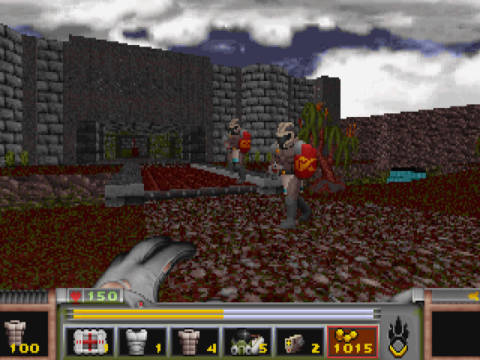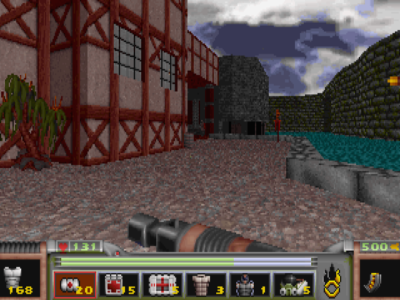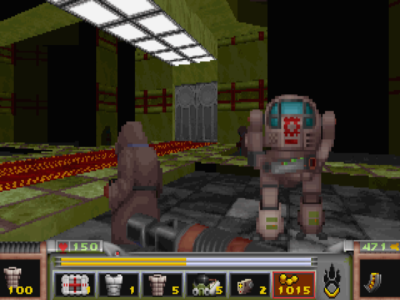
Strife
Written by: Stoo
Date posted: November 21, 2025
- Genre: Action
- Developed by: Rogue Entertainment
- Published by: Studio 3DO (EU), Velocity (US)
- Year released: 1996
- Our score: 9
In the 90s there were essentially four major commercial games that used iD software’s Doom engine. Starting with Doom itself, the game that basically defined what a first person shooter was for several years. To keep things simple I’m also going to count its sequel and expansions (Ultimate Doom, Final Doom, Oh no More Doom) as a single entry on our list.
Then we have the ones where other developers licensed the engine from iD. At the time this was a new and exciting idea – freed from having to think of the basic nuts and bolts of an engine, what could the devs think of? So each of these Doom-powered games came with a different idea of what to do with the technology. Raven’s Heretic played it fairly safe, basically more Doom with a few tweaks and then elves and wands instead of demons and chainguns. Its follower Hexen got a little more creative, with hub-based levels and more puzzles.
Then in 1996 came the final member of the group. A bit late to the party, you might say – tech moved faster back then and the Doom engine was rapidly aging. So that’s likely a reason that Strife wasn’t a major success, as we’ll discuss a bit later. Yet it’s is an absolutely fascinating title, with ambitions far beyond those of most shooters of the time. Blending in RPG elements, it almost a precursor to the immersive sims of later years.
A bold claim, yes! However a quick clarification is needed before I get underway – remakes and remasters abound these days and so we should be clear which version of a game we are discussing. In this case there is remastered “veteran edition” with high res graphics, improved lighting, additional multiplayer modes etc. However when I first review something I prefer to stay closer to the original experience (even if I’m not firing up an ancient beige 486) so today we are looking at the DOS original.
Here’s the premise: Strife takes place on some un-named world, where an impacting comet unleashed a terrible plague. Many of the infected died, others decided they could now hear God. Forming a militant organisation known only as The Order, these fanatics took control and imposed their brutal rule on the rest of the population.

Unsuspecting Order goon on a stealth level.
There’s where you come in, a mercenary who’s found himself captured by The Order. You start out in an small holding facility, armed only with a dagger while an Order goon luckily has his back turned. So you stab him to death, grab some health and ammo for a gun you’ll hopefully get soon, then fight your way past another soldier. If your frame of reference is Doom and Duke Nukem you may now be preparing yourself to fight your way through a lot more goons to reach the level exit, in true 1996 style.
However something unexpected now happens. There’s a guy behind a desk and… he doesn’t attack you. In fact he just wants a chat. He has a mission for you, a promise of cash reward and also he can connect you to other people who might want your services, an army of rebels fighting the Order.
From here you emerge, still not into a level full of baddies, but a peaceful town. Sure, there are more Order goons here but as long as you mind your own business they remain passive. You’ll find shops to buy weapons, ammo and health items. A tavern is filled with civilians and goons hard at work on their daytime drinking. There’s also a secret rebel base hidden amongst some ruins. Throughout the game this town will act as a hub to replenish and restock yourself, collect rewards and pick up new orders. The missions then take place in adjoining regions.
At the time, all of this would have looked like the setup for a fantasy RPG. In fact Strife does have some lightweight RPG character-progression attributes, in the form of permanent upgrades to health, melee strength and accuracy that are doled out after missions. Still, this is hardly an Elder Scrolls or a Might and Magic that we’re playing. Once combat actually starts we are firmly back in 90s FPS territory. You’re charging about at Olympic sprinter speeds (despite carrying seven guns and twenty first aid kits) spraying baddies with bullets, or circle-strafing giant robots.
So then, how best to sum up what sort of game this? It occurred to me, after playing for a while, that one way to describe it would be a kind of proto-Deus Ex. Look at it in broad terms: a first person game with NPCs, neutral hubs, missions, an actual plot. Oh and it even has a similar sort of voice in your ear, a mission-control type person throwing you bits of info and commenting on events.
(As an aside, there was another game merging RPG and shooter elements back then – the revered System Shock. Yet, that one was coming at the mix from a different angle. With no NPCs or neutral territory, it’s more about surviving in a giant space-dungeon.)

Portraits like this pop up when interacting with NPCs.
As Strife progresses it comes up with other ways to impress me – how about a stealth mission? The idea is you’re going incognito, so Order troops will only turn hostile if attacked or if they hear something that alerts them. You can roam with impunity to some extent, but will eventually run into doorways that are alarmed. Also robots see through your disguise and the only silent weapon that works on them on them is your dagger. So you should either studiously avoid trouble, or try to quietly pick off as many baddies as you can in isolation, before an alarm is raised.
Then a few missions later you have the entire rebel army storm an Order castle. Which means a huge pitched battle with you and dozens of friendlies vs order troops and supporting robots. The friendlies are not especially smart or powerful but it’s gloriously chaotic, as your troops surge forward and then the robots let rip with a barrage of rockets. It’s tempting to just run for cover but I’m the kind of ridiculous gamer who feels bad when nameless sprites on my side are getting killed. So I found myself making lots of hasty assaults on enemy positions, hoping I had enough health kits to see me through to the end.
Later on your focus shifts to killing off the various leaders of the Order, which basically means boss fights. Funnily enough the first was the most frustrating, as I found myself getting repeatedly one-shotted. The rest are somewhat less unfair. You also start assembling an ultimate weapon called the Sigil, which shoots lightning in different forms depending on how many pieces you’ve found. It drains your health instead of using ammo, but it’s also the only thing that works on most bosses.
I played through on medium and the level of challenge seems about enough for my Dad Gamer levels of skill (and limited allocations of free time). Later on the basic goons take a back seat and you’re up more often up against robots and power-armoured elites. At the same time, there never seems to be quite enough ammo lying around. So you really do want to scour every map for secrets and supply caches. That or you can run back to down and buy stuff, although the game is not super generous with money either.

Some pretty convincing town and castle maps, considering it’s the Doom engine.
We should probably discuss what the game does wrong – or at least, why it didn’t have more impact. I mentioned the Doom engine becoming outdated – in fact, ID’s next generation Quake came out at almost the same time. With its proper 3D engine, it could construct more realistic environments with features like ramps or floors above each other. Meanwhile, enemies were 3D entities with depth and full animation. In comparison Strife is stuck in a 2.5D world where a “bridge” is a solid wall down the water, and the enemies are blobby sprites.
It’s illustrative to look back at issue 43 of PC Zone (our official favourite gaming mag) where both Strife and Quake were reviewed. The writer actually does acknowledges Strife’s innovations, but seems to think they are of little consequence. The overall tone is unenthusiastic. The single page review ends in a lukewarm score of 70% and the summary “interesting enough but overshadowed by you know who”. Quake meanwhile gets the front cover, 16(!) pages within, a score of 96%, and “****king brilliant”.
I would disagree with both assessments, and I was never particularly impressed with Quake. However, I don’t want to spend a lot of time arguing with reviews from 30 years ago, and I understand what motivated both writers to come to their conclusions. The move to true 3D engines was exciting, after all, and a major shift in gaming technology. We retro gamers, however, can look at Strife from a different perspective. Everything we write about here uses some kind of outdated technology. So what we would ask is, do the graphics adequately carry out the task intended for them by the developers? Or do their flaws distract us from the experience?
Myself I’d say Revolution used the Doom engine remarkably adeptly. Doom itself could be quite abstract (this is a toxin refinery because we say it is) but here locations like courtyards, castles and taverns are quite convincing, even without rooms-above-rooms. There’s a strong techno-medieval aesthetic tying it all together coherently, with robots and computers alongside the old-timey town and civilians dressed like ye olde peasant farmers. It’s also rarely drab, with a bunch of distinctive themes – wealthy areas like the governor’s mansion, more austere fortifications, and vaults of green stone where it all gets a bit weird deep within Order headquarters. Whereas, as I repeatedly point out [yes, you do – Ed.] Quake, for all its technical wizardry was rendered almost entirely in shades of grey and sludge.
Whenever you talk to someone a portrait screen pops up. These aren’t animated but, they still give the characters just a bit of life. It’s a good idea, compensating for the lack of detail that can be conveyed in a blobby Doom sprite. I should mention also that periodically you get bits of backstory depicted with quite eye-catching, comic book style images.

Power armoured troops are a lot tougher than ordinary goons.
I should take a minute to think where else Strife might have put a foot wrong – I will say the last level was a slog through some fairly uninteresting grey corridors. I guess some unspoken rules of gaming say at the end we have to go to the baddies’ Final Ultimate Fortress or some such. It’s meant to be a climax but this thinking doesn’t always make for the greatest levels. Remember the endless featureless corridors in Vampire the Masquerade: Bloodlines? Here we really could have done with a bit more imagination, of a send-off from the NPCs, and maybe some extra gold to stock up on ammo.
So as I try to sum this all up, I should return to that Bold Claim, and admit that I have to clarify exactly what I mean. It’s not quite an early occurrence of the sort of immersive sim that emerged around 2000. There’s no character skill system for a start. More broadly there isn’t the sort of freedom to find your own play style and approach problems in multiple different ways, that tends to be central to the immersive sim concept. The plot is also fairly straightforward, and most dialogue fairly brief.
Still, I stand by calling it a precursor to such games. I remember playing Dark Forces, on that level in some smugglers’ city and thinking, and thinking it seemed wrong that only hostile entities exist. If you’re creating a 3D city, why not have people to talk to, or shops you can use? Well, Strife was one of the first games of its kind to do exactly that, and it’s a step towards something like Deus Ex.
Not to say Warren Spector ever played this and thought “hmmmm”, and I’m not claiming it was super influential either. Only that it’s an example of the genre growing, maturing, and evolving towards more complex forms. A step towards games where you’re an agent in a believable world, investigating and interacting with it. Even this one ended up relatively obscure, other developers were trying similar ideas and would continue to do so. They realised we could take this whole “smooth scrolling first person 3d action” concept that iD had so masterfully created, and do more with it than just run around a maze shooting monsters in the head.
So then that’s Strife, kind of a paradoxical game now I think about it. A first person game from 1996 using the technology of 1993, but looking forwards to what the genre could become several years later. It probably has more little faults and annoyances that I’ve glossed over along the way, to be fair. Maybe those bastard little flying laser droids? Yet I’m unapologetically enthusiastic for an immersive game with driven by some innovation and creative vision. So let me give it our top recommendations; for retro shooter fans it’s absolutely worth your time.


 Posts
Posts
This might be what finally gets me to play Strife.
December 5, 2025 @ 6:22 pm